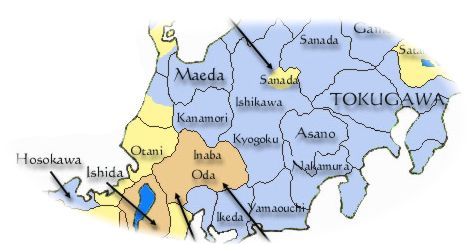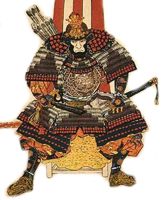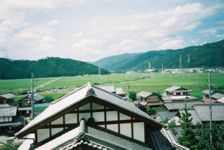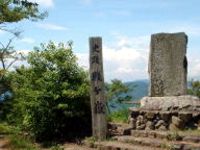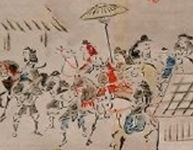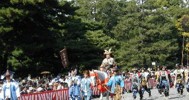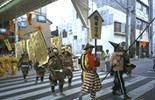ONE-MINUTE BIO
OF THE REAL-LIFE
ODA NOBUNAGA
PLUS
TOYOTOMI HIDEYOSHI &
TOKUGAWA IEYASU
![]()
| ODA-TOYOTOMI-TOKUGAWA | 1534 - 1545 | 1546 - 1560 | 1561 - 1570 | 1571 - 1582 | 1583 - 1615 |
Popular
Profile & Summary of Bio
..... Oda Nobunaga
..... Toyotomi Hideyoshi
..... Tokugawa Ieyasu
If you are in a hurry, click one of the names above. Every important fact
is already there in brief,
and you might find some fun and weird truths that are not dished out within
the 'scientific' biography.
Oda Nobunaga's 25 years-old third son, Oda Nobutaka, who wanted to be the head of the clan, committed suicide after getting defeated in battle by Toyotomi Hideyoshi who fought to install Oda Nobunaga's grandson from Nobutada, Oda Hidenobu (Samboshi, 3 years old), on the much-coveted seat. Shibata Katsuie, Nobutaka's ally in all this, also died the same way, with the former Lady Oda Oichi, Nobunaga's sister, his wife. But the all-female kids gotten from Oichi's previous marriage to Asai Nagamasa were saved by Toyotomi. The eldest of these, Lady Asai Yodo, became his concubine and mother of his one and only offspring (although many never believed that this was really his son) Toyotomi Hideyori (click here for story and pictures).
The
location of Shizugatake war in 2002 (left) and monuments
to remember the battle by (not left).
Shibata had tried to get Tokugawa Ieyasu to back him and Oda Nobutaka up, but Tokugawa didn't want to get involved in this internal feud -- it didn't matter to him which side won or lose, he knew one day he would have to face the victor himself. Yet maybe the strongest of the Oda Generals (Shibata was, actually) was just darn unlucky because Oda Nobutaka panicked before the time for a joint attack came, and started to fight too early. None of other elements of this anti-Toyotomi force was ready when Oda Nobutaka performed his warcry. Former Oda Captain Takigawa Kazumasu also lost big time because of this.
Here at last began the reign of Toyotomi Hideyoshi, who got his 48th birthday this year, and he brought in the Golden Age of this habitually turbulent medieval Japan. He got all the previous territories of the Oda clan, and made peace with everybody outside this domain. The Emperor gave him the title of 'Lord Chief Minister' ('Kuampaku' in Japanese) -- no one would have even dreamt of such a thing back then regarding this farmer's son. Toyotomi became some bytes more rigid than during Oda's times, in stuff like the chain of command, ranks and so forth, but he was generally seen as being much easier to forgive, and spared a lot more people than Oda usually did after every battle. To be exact, this was the year when he used the name 'Toyotomi' (why haven't I mentioned any other name, click here), which meant 'The Bountiful Ruler'. Before all that, though, fightings first. Oda Nobuo, the ne'er-do-well second son of Nobunaga's, started the year by asking Tokugawa Ieyasu to help him battling against Toyotomi Hideyoshi and made him the heir of Oda Nobunaga. Since it was fitting to his own plan, Tokugawa seriously led an army for that purpose. The series of wars (at Komaki, Nagakute, etc.) was a total waste of time, energy, gunpowder, and lives. During the battle, both Tokugawa and Toyotomi felt disinclined to move on, knowing fully well that it wasn't an Oda battle for chief-of-the-clan title; it was theirs for supremacy over Japan. Always cunning, Toyotomi chose the backstreet. He approached the bad seed Oda Nobuo, and talked him into peace. Tokugawa automatically cancelled his moves, and all was well again as far as Toyotomi and Tokugawa were concerned. The only excuse for this useless series of killings (although it made some of Toyotomi's Captains famous, like Gamo Ujisato and Tsutsui Junkei) was that it determined at last who was to step into Oda Nobunaga's shoes first. By outwitting Tokugawa Ieyasu, Toyotomi Hideyoshi had thereby gathered the warlords of Japan under his reign. And by withdrawing his troops after the Toyotomi-Nobuo peace pact was sealed, Tokugawa had signalled that he had no bad feeling about it, politically. Oda Nobuo became attached to Toyotomi Hideyoshi, but in the exact opposite role compared to his late daddy's. He marched to war under Toyotomi's banner to subdue the remaining hostile warlords from this year onwards. His uncle Oda Nobukane, Nobunaga's brother, joined in. The Odas were now Toyotomi's vassals.
This was the year when the infamous Sword-hunt Edict of Toyotomi Hideyoshi's was issued: from now on no one was allowed to keep, let alone use, swords, except the samurai class. Some might take this as a psychopathological thing -- because of his own DNA that wasn't related to such a privilege, Toyotomi tried to harness all the peasants from aspiring to become like him. It was a further-reaching policy than we today may think. All the times before, Japanese warlords relied on the peasantry to man their troops -- and when there was peace, these temporary soldiers got back to rice-planting. It was a workable concept, better than the case of manorial farmers of medieval Europe. But now you got to be of a samurai descent to do martial arts. Despite the infamy, the edict didn't cause any notable unrest. Perhaps it was because the people of Central Japan thought that Toyotomi's reign was peaceful somewhat; they didn't know and didn't care about the ongoing wars that Toyotomi waged outside the horizon that they could perceive (Kyushu was as good as being in Mars, as far as the Central Japanese inland citizens were concerned, while Korea was as dimly imagined as Planet Zork). Thus the 'Golden Age'. Not that the warring period was over, but because it was over right there where the 'vocalists' of the era dwelt at.
Toyotomi Hideyoshi started to plan invasion of Korea -- the land that Japanese from time immemorial habitually thought of as 'theirs'. His famous Generals, 29 years-old Kato Kiyomasa and 36 years-old Konishi Yukinaga (click here for story and pictures), were to lead the averagely successful destroyers across the waters.
Toyotomi Hideyoshi was officially the Lord Chancellor of Japan ('Taiko') this year. Or the exact translation meant something like 'Retired Chief Minister Who Nonetheless Is the Power to Reckon With Since the Present Chief Minister Is Only His Nephew And He Never Makes Any Executive Decision Or Laws And No One Asks For His Permission To Do Anything But Instead Everybody Appeals To the Retired Chief Minister'. There had never been such an Imperial title before; but Toyotomi's humble origins baffled everyone who had been trying to catch any glimpse of heaven-tied mandate to rule the united Japan. So they made this up, tailored exclusively for him. In return for Toyotomi's well-known lavish spending for the entire Imperial family, this was of course natural. He really pampered the courtiers and the Emperor himself.
He gave the title 'Chief Minister' ('Kuampaku') to a son he had just adopted, Toyotomi Hidetsugu -- originally his nephew. Toyotomi had started to get really down whenever thinking of dying without leaving his own kid behind; all dalliances with various consorts and such never gave him any kid. When he got one, the baby died a few weeks after birth.
Finally, when Toyotomi Hideyoshi was 60 years old, this year an heir was born, named Toyotomi Hideyori. His mother was Oda Nobunaga's niece, the former Lady Asai Yodo (click here for story and pictures). The Korean invasion was all ups-and-downs, so this must have been a tremendous boost to Toyotomi Hideyoshi's spirit, despite the fact that he had started to feel ill. That couldn't have been the reason, but the former heir, Toyotomi Hidetsugu, was exiled. And that wasn't enough yet for Hideyoshi, so the young man was forced to commit suicide, and his entire family were all executed. This was to keep the path to succession clear for Hideyori. It was uncharacteristically unnecessary, the slaughter of Hidetsugu's family; perhaps Hideyoshi got a great qualm about the issue remembering how the Oda clan crumbled because of succession dispute.
Toyotomi Hideyoshi died this year at 62. Before that, he had time to form a council of regents and advisors for Hideyori, consisting of his old-time buddy 62 years-old Maeda Toshiie (click here for story and pictures), accompanied with his most prominent Generals from different most powerful clans: 43 years-old Uesugi Kagekatsu, 27 years-old Ukita Hideie, 45 years-old Mori Terumoto, and 55 years-old Tokugawa Ieyasu, who had been, during Toyotomi's reign, more of a vassal rather than an ally like when Oda Nobunaga was around. To continue the application of his rules, he also appointed Asano Nagamasa, Ishida Mitsunari, Natsuka Masaie, Maeda Geni, and Mashita Nagamori to man a body of administrators.
Tokugawa Ieyasu -- when he turned 60 years old -- announced that from now on he was the Shogun. Meanwhile, Oda Nobunaga's grandson Hidenobu died at 21 in obscurity. The 10 years-old Toyotomi Hideyori found the council that daddy left for him split up, following the death of the one and only true friend of Hideyoshi's within it, the venerable Maeda Toshiie. Nevermind his age, Toyotomi Hideyori was still the Chief Minister of the Empire, since the title was hereditary; but power was all in Tokugawa Ieyasu's hands in real life; something that was only natural after what happened in Sekigahara. Actually Hideyori was already lucky enough not to get killed, though being the husband of Tokugawa Ieyasu's grand-daughter (the famous Lady Tokugawa Sen) didn't mean immunity.
Tokugawa Ieyasu announced his retirement, and the Shogun from now on was his son Tokugawa Hidetada. Ieyasu then moved out of Edo to Sumpu, Suruga, where he spent so many years as a hostage of the Imagawas. Why there, it's an enigma. But he actually never severed ties to that clan; the Imagawas which Oda Nobunaga wanted to wipe off the planet's surface and of whom Toyotomi Hideyoshi never cared a fig, were now taken to the capital as practitioners of court ceremonies and other such cultural stuff.
Though retired and 'untitled', Tokugawa Ieyasu kept on with national decision-making; this year he issued an edict that confined the courtiers and noblepersons to ceremonial stuff, away from warring things. His thought forever dwelling in dynasty-building, he obviously got a bit worried about chances that some martial-minded princes one day rises up against his clan's shogunate. Perhaps he already got a vision of Emperor Meiji (click here for story and pictures).
And now Tokugawa Ieyasu released the farthest-reaching Christian Expulsion Edict, overwriting that of Toyotomi Hideyoshi's reign. The anti-Christianism stance was to be adopted by the next Shoguns, too, with increasing hostility; but it was Ieyasu's grandson Tokugawa Iemitsu who dealt with this subject most decisively. Iemitsu did the hunt of Catholics, killed them if they were Japanese, or put them onto ships to never ever get back again to Japan if they were foreigners (click here for story and pictures). After that, he closed Japan off.
Tokugawa Ieyasu died at 70. But, true to his character, there was no messy internal fight for the vacant seat that he left behind, because you can't aspire to be the patriarch of the clan, can you? For the next 254 years the Tokugawa clan would rule Japan, for the most part of it closing it off from the rest of the world. The Nemesis wouldn't come on them until 1868 -- when Emperor Mutsuhito wanted his ancestors' power back. Click here to continue to his times, known to us as the Meiji Restoration.
|
||||||||||||||
| ODA-TOYOTOMI-TOKUGAWA | 1534 - 1545 | 1546 - 1560 | 1561 - 1570 | 1571 - 1582 | 1583 - 1615 |
Samurai Blog (Updated Everyday)
HOME  LINKS
LINKS
 CONTACT
CONTACT
 CREDITS
CREDITS
 COMMENTS
COMMENTS
Site © 1996, 1997, 1998, 1999, 2000, 2001, 2002, 2003, 2004, 2005, 2006 Nina Wilhelmina
